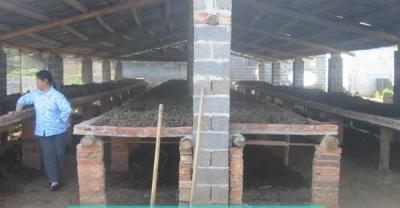Selection of earthworm culture sites and 12 culture methods
Outdoor breeding site selection:
1. Site requirements
The main results are as follows: 1. Back to the sun, ventilation and drainage are good, so as to adapt to the habit that earthworms like to be dark and go out at night.
2. The site should be waterproof and rainy.
3. Avoid places where people are noisy, vibrating and noisy.
4. there is no pesticide and other poison pollution, and can prevent the harm of snakes, rats, frogs, ants and so on.
II. Soil quality requirements
1. It is best to use humus, and clay is strictly prohibited.
2. The pH is neutral.
III. Water quality requirements
The water is sanitary, clean and pollution-free, it is best to use groundwater.

Twelve breeding methods
1. Pond culture
You can make use of balconies, corners and other idle places to build ponds for breeding.
Use bricks indoors to form a checkered pool with a size of 5 square meters, which is about 25 cm high and loosens the soil by more than 10 cm. Or build a pool with a length of 2 meters, a width of 2.5 meters and a depth of 0.4-0.5 meters, or build it one by one according to the row spacing of about 0.5 meters. If the groundwater level is high, do not dig the bottom of the pool and use bricks to base the pool directly on the ground. If the terrain is high and dry, you can dig down a 40-50mm deep pool to take advantage of the temperature and humidity in the pool.
2. Pot culture
It can be raised in flowerpots and other devices. Suitable for breeding Aisheng worms, tiny double-chest worms, back dark different lip worms and so on.
Common containers such as flowerpots can raise 10-70 worms. The amount of feed put into the basin should not exceed the depth of the basin by 3 to 4. In this way of breeding, the temperature and humidity of the soil or feed in the basin are easy to change, which need to be mastered.
3. Cylinder cultivation
Drill a 1-2 mm round hole at the bottom of the cylinder for drainage and cover it with 10 cm thick breeding soil.
4. Culture in bed
Directly spread the breeding soil on the ground to make a breeding bed, the area of the breeding bed is 5-6 square meters, and there are ditches with a width of 30 cm and a depth of 50 cm, which can not only be drained, but also used as a protective ditch.
5. Boxes and baskets
Can be cultured in packing boxes, cartons or plastic boxes, wicker baskets, bamboo baskets and so on. The area of boxes and baskets shall not exceed 1 square meter. The bottom part and side of the culture tank should have drainage and ventilation holes. The pore diameter of drainage and ventilation holes is 0.6-1.5 mm.
6. Trench culture
Select the leeward shade and dig trenches for breeding. The groove is 10 meters long, 2 meters wide and 60-80 mm deep. The upper side of the groove is slightly lower and the other side is slightly higher, with a certain inclination.
The bottom of the ditch is covered with 15cm thick breeding soil, and the ditch is covered with rainproof materials such as film, plastic board, bamboo curtain and so on. It can store 3000-500earthworms. A good drainage ditch should be opened around the surface of the ditch, and the raising soil at the bottom of the ditch should be stacked into a prismatic shape to drain water.
7. Box three-dimensional culture
Three-dimensional intensive breeding can be carried out by overlapping the same specifications, which is one of the commonly used breeding methods at present.
Make wooden cases and shelves first. The shelf can be welded with steel bar or angle iron or built with bamboo or wood, or built with bricks, cement boards and other materials. Aquaculture tank water 50 cm, 35 cm wide, 25 cm high, put on the shelf, generally put 4-5 layers.
Put more than 10 cm loose soil in the box and cover it with a breathable anti-escape net. When breeding, pay attention to ventilation, adjust temperature and soil moisture, and keep the soil clean and indoor sanitary.
8. Culture in plastic shed
Earthworms can be cultured in existing winter greenhouses and greenhouses.
9. Underground cellar culture
Breed in dark, moist, warm places such as air-raid shelters, civil air defense fortifications, pits, caves or soil cellars.
10. Semi-basement culture
Choose leeward, dry slopes and dig trenches with a depth of 1.5-1.6 meters, a width of 2.5 meters and a self-defined length. One side of the ditch is 1 meter above the ground, and the other side is 30 centimeters above the ground, forming a slope, which is covered with double-layer plastic film.
11. Garden and field culture
Choose mulberry orchards, vegetable gardens, orchards or feed fields that can be irrigated with flat terrain, open grooves 35-40 cm wide and 15-20 mm deep along the rows of plants, and apply organic fertilizers such as rotten livestock and poultry manure and domestic waste, which are covered with soil for about 10 hundred meters, and put in earthworms for breeding. The ditch should always be kept wet, but no water should be accumulated. This culture method should not be trenched in gardens with citrus, oak, cedar, pine, fir, eucalyptus and other gardens.
12. Simple stacking culture
①, site: choose flat land with high terrain, close to water source and no stagnant water as breeding farm.
②, material preparation: using cow, horse, sheep manure or other livestock and poultry manure, then adding 30% hay, mixing well, composting and fermentation.
③, seed: the stacked feed, after adjusting the humidity, is laid in the selected place. The stack is 1-1.2m wide and 15cm thick. Evenly put the earthworm species containing egg blocks and young worms, and cover them with a pile of 5 cm thick.
④, covering: covering with thin film
⑤, escape prevention: surrounded by 3mm nylon mesh, or digging ditches.
For more aquaculture techniques and business guides, please see the mobile version of http://m.yzydt.com, or follow Wechat official account: yangzhiuu; service number (mall): yangzhimall, Wechat private number: yzydt1.
- Prev

Culture technology: breeding and pest control of Chunjian
Spring Jian is often called authentic Sichuan orchid. Although there are famous products in Yunnan, Guizhou and Sichuan, Sichuan orchid is the most expensive. Chunjian is a monocotyledonous plant, belonging to Orchidaceae. It is 20-40% high.
- Next

Aquaculture of Qili incense
Qilixiang, also known as Wanlixiang, Qianlixiang, Guoshan incense, Sijiqing, etc., like high temperature weather, generally born on the coast, mainly distributed in Taiwan, Hainan and other places.
Related
- On the eggshell is a badge full of pride. British Poultry Egg Market and Consumer observation
- British study: 72% of Britons are willing to buy native eggs raised by insects
- Guidelines for friendly egg production revised the increase of space in chicken sheds can not be forced to change feathers and lay eggs.
- Risk of delay in customs clearance Australia suspends lobster exports to China
- Pig semen-the Vector of virus Transmission (4)
- Pig semen-the Vector of virus Transmission (3)
- Five common causes of difficult control of classical swine fever in clinic and their countermeasures
- Foot-and-mouth disease is the most effective way to prevent it!
- PED is the number one killer of piglets and has to be guarded against in autumn and winter.
- What is "yellow fat pig"? Have you ever heard the pig collector talk about "yellow fat pig"?

